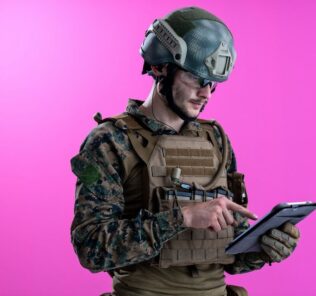How Healthcare Simulation Can Help Mitigate Workplace Violence
Healthcare simulation allows learners to build upon their education and actively work to solve problems by navigating through clinical simulation scenarios. Ultimately, healthcare simulation benefits learners by better preparing them for what they may someday encounter in the field. One such encounter that clinical simulation can help prepare learners for is workplace violence. This HealthySimulation.com article explains the importance of workplace violence education and how organizations can utilize healthcare simulation techniques to incorporate enhanced strategies and mitigate such behaviors.
As educators design scenarios, they promote comprehension, hands-on learning, and a real sense of critical thinking and problem-solving. Regardless of the specific scenario, learners will experience realistic situations that force them to rapidly assess the situation and formulate a real-time action plan. Healthcare simulation is not a new concept across health education, and the practice has come to provide limitless ways for learners to gain knowledge and insight. As clinical simulation is now possibly both in-person and remote, the number of learners able to be reached has also become vastly expanded. Through evidence-based research, the use of clinical simulation resources, and course development, learners are now presented with realistic training environments from which they can gain valuable experience.
Unfortunately, workplace violence – especially that geared toward healthcare staff – has become one potential experience which training must be provided for. The violence rate against healthcare staff is four times higher (1) than any other type of occupation, and female nurses are said to be the most common victims of violent acts. Further, the National Library of Medicine article “A Systematic Literature Review: Workplace Violence Against Emergency Medical Services Personnel” states that, “Today, it is generally accepted that WPV is a common occurrence among medical jobs, and statistics show that 70% to 80% of doctors, nurses, emergency medical personnel, and public service workers will encounter one or more instances of violence annually.”
Sponsored Content:
As a result of these staggering statistics, there are a variety of virtual training courses to assist in violence prevention education for healthcare staff. The Centers for Disease Control (CDC) offers nurses a specific system for violence prevention. (2) Another option geared toward any healthcare worker is a program developed by the Crisis Prevention Institute (CPI). CPI is known to offer training courses (3) to organizations, of which options focus on de-escalation and nonviolent intervention techniques.
While there isn’t a lack of training options, there does exist a concern about each training option’s overall effectiveness. Healthcare employees have repeatedly reported not feeling confident in violent situations, but specialized training has proven highly beneficial. Yet, when skills and techniques aren’t implemented regularly, individuals continue to lose their sense of comfort. For this reason, healthcare organizations must shift their mindset to allow for more unique educational options, such as that incorporating healthcare simulation.
Workplace Violence Training Example
By developing programs that portray simulated patients as violent offenders, confidence levels have the potential to improve. By taking an online course, a nurse may not feel confident when faced with a violent patient trying to attack them. If there is an in-person clinical simulation training component used during their medical education, staff can learn the basic skills necessary to mitigate the situation. Programs must be prepared to go beyond a typical in-person training session where demonstrations are provided. Providing clinical simulation scenarios that are as realistic as possible is key.
Sponsored Content:
Healthcare simulation educators should not forget that the timeframe following a clinical simulation scenario is when participants should reflect on the scenario and share feedback. This step is extremely important to a medical simulation scenario as debriefing promotes a safe, open learning environment. The goal is to allow for a healthy discussion during which learners can contemplate elements of the scenario that went well or that could be improved upon in the future.
In general, healthcare simulation presents a unique opportunity to help learners become better prepared for workplace violence when they enter the field. As workplace violence remains an issue across medicine, more healthcare simulation centers, programs, and facilities should consider implementing lessons on how to mitigate these circumstances. The better-trained learners become in being able to address workplace violence, the safer the facility in which they work becomes.
Note: The effectiveness of clinical simulation training programs, especially as they relate to workplace violence training, can vary depending on the methods chosen by the professionals. Healthcare simulation has proven results in being an effective teaching strategy, and by creating educational programs with simulated patients healthcare organizations can train on this very real concern across the medical field. The first time a nurse has to implement de-escalation or violence prevention strategies should not be when a patient tries to attack them in real time.
More About Standardized Patients
Standardized patients (SP) are a component of clinical simulation that has grown in popularity in recent years. Standardized patients involve a person coached by faculty to portray real-life patients. Like acting, faculty or educators design healthcare simulation scenarios so that the SP can play a specific part.
Individuals chosen will likely depend on each specific organization and budget. Some organizations advertise on campus for willing participants; others list them as healthcare simulation job opportunities. As an incentive, most standardized patients do get paid for their time. That said, SPs can be anyone from the community or from within the organization. Learners interested in acting could also apply and serve as an opportunistic recruiting option.
The goal of healthcare simulation using standardized patients is to provide realistic educational experiences. Each trained patient is expected to provide responses and exam findings in real-time, allowing learners to feel as if they are in actual healthcare settings.
The more authentic the SP experience, the more likely the learning outcomes can be achieved. Learners who can gain the most benefit by interacting with standardized patients include nurses and nursing learners, as well as all medical learners. Advanced practice students (PAs, APRNs, etc.), physicians, and varied other allied professionals (CNAs, respiratory therapists, physical therapists, etc.) can also find ways to improve upon their treatment and professionalism while training with an SP.
Learn More About Standardized Patients
References:
- https://www.ncbi.nlm.nih.gov/pmc/articles/PMC6801794/
- https://www.cdc.gov/niosh/topics/violence/training_nurses.html
- https://www.crisisprevention.com/Training-and-Events?specialty=APS&program-type=CC-10100174
Krystle Maynard is the creator of Innovative RN Solutions and has been a nurse for over a decade. She has specialized in medical-surgical and critical care nursing, in addition to having a long-standing history of being an adjunct faculty member for a college of nursing. Innovative RN Solutions focuses on healthcare content writing (such as blogs, E-books, emails, academic coursework, and educational content for healthcare personnel and patients). Krystle also offers tutoring and mentor services for undergraduate and graduate nurses. She lives in Kentucky with her husband and children.
Sponsored Content:




















